A3429
Differentiation Solution
for the differentiation of regressive hematoxylin stains
Sinónimos:
Acid Alcohol
About This Item
Productos recomendados
formulario
solution
caducidad
40 mo.
color
colorless
aplicaciones
hematology
histology
temp. de almacenamiento
room temp
¿Está buscando productos similares? Visita Guía de comparación de productos
Descripción general
Aplicación
- the prediction of pulmonary metastasis progression in osteosarcoma patients
- the development of multispectral imaging to detect melanin
Características y beneficios
- Desired staining patterns can be obtained by varying the degree of exposure to the differentiation solution.
- Results are sharper and more rapid compared to other differentiation methods.
- Crisp and clear differentiation between cellular structures is obtainable when performed according to Sigma-Aldrich Procedure No. GHS.
Principio
Palabra de señalización
Danger
Frases de peligro
Consejos de prudencia
Clasificaciones de peligro
Eye Irrit. 2 - Flam. Liq. 2 - Met. Corr. 1 - STOT SE 2
Órganos de actuación
Eyes,Central nervous system
Código de clase de almacenamiento
3 - Flammable liquids
Clase de riesgo para el agua (WGK)
WGK 1
Punto de inflamabilidad (°F)
71.6 °F
Punto de inflamabilidad (°C)
22 °C
Certificados de análisis (COA)
Busque Certificados de análisis (COA) introduciendo el número de lote del producto. Los números de lote se encuentran en la etiqueta del producto después de las palabras «Lot» o «Batch»
¿Ya tiene este producto?
Encuentre la documentación para los productos que ha comprado recientemente en la Biblioteca de documentos.
Nuestro equipo de científicos tiene experiencia en todas las áreas de investigación: Ciencias de la vida, Ciencia de los materiales, Síntesis química, Cromatografía, Analítica y muchas otras.
Póngase en contacto con el Servicio técnico








